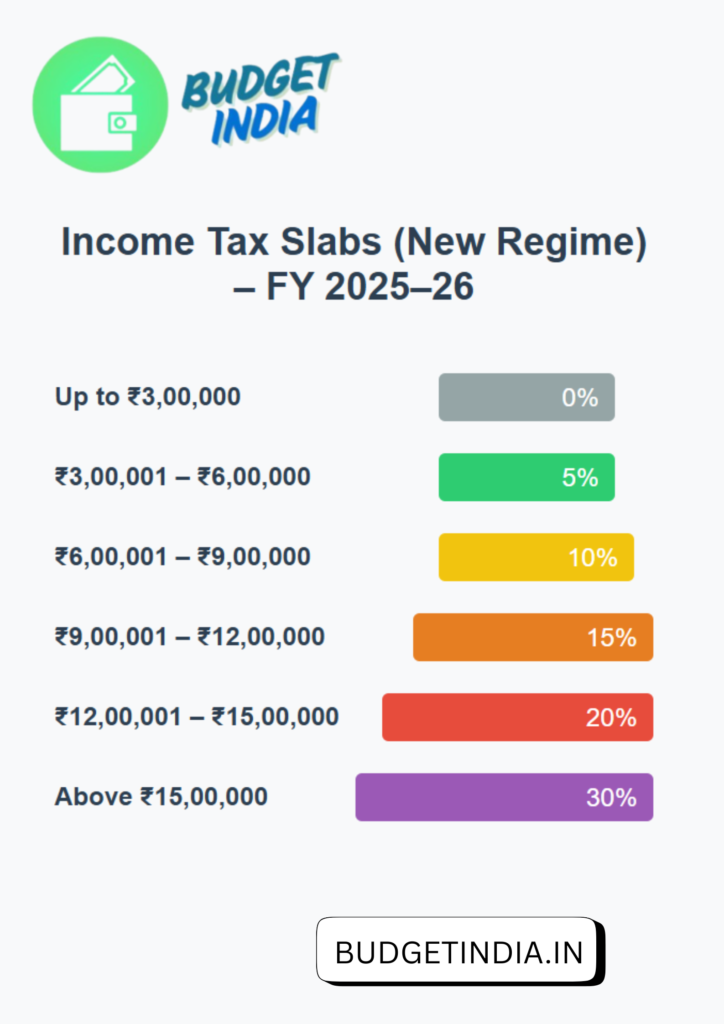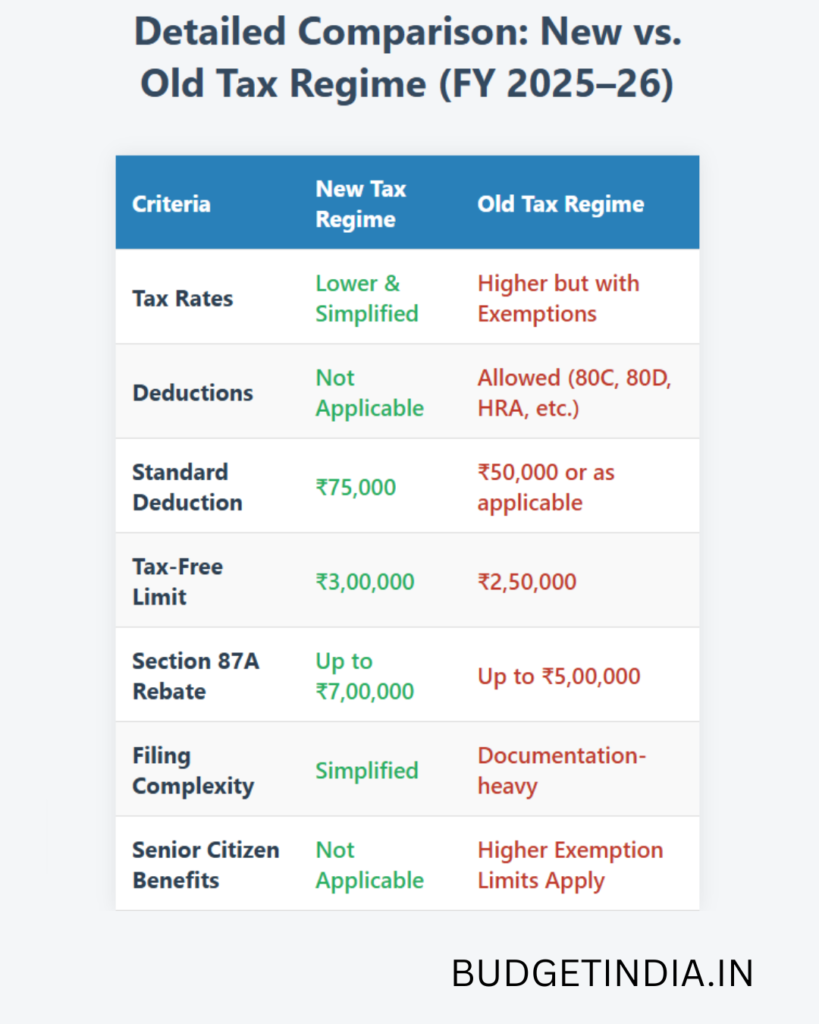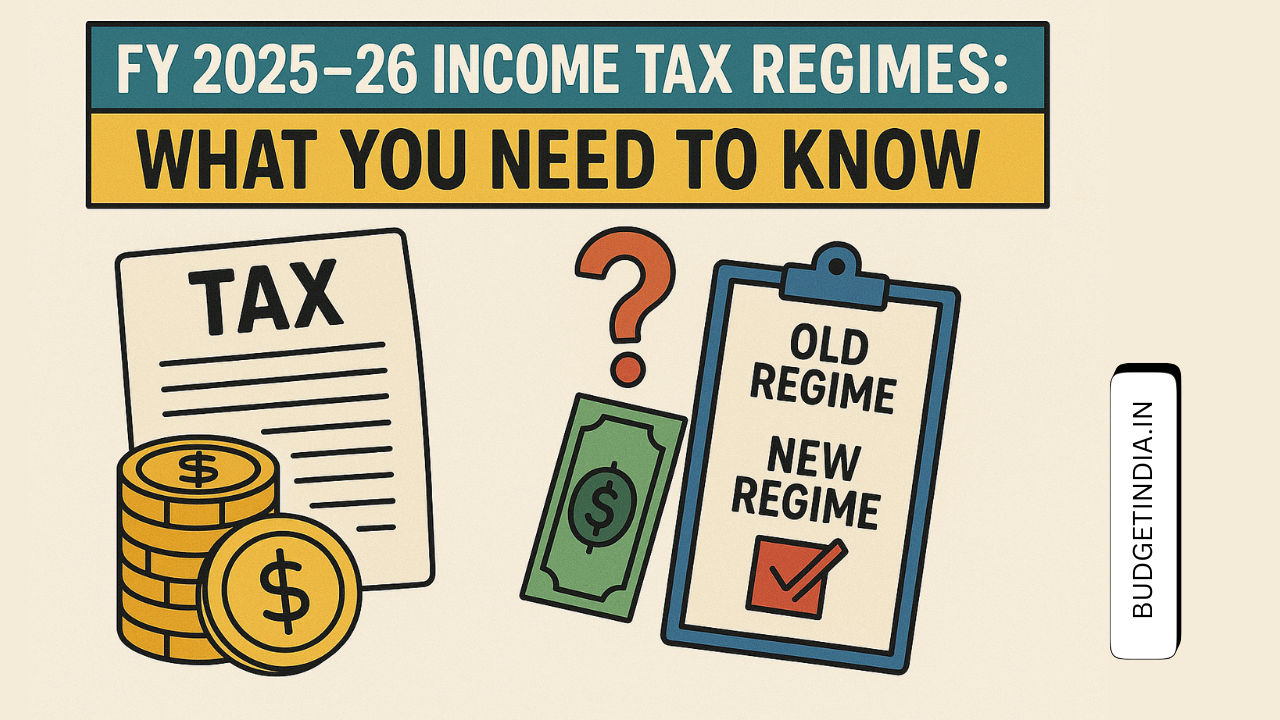India’s income tax structure operates on a progressive scale, where tax liability increases with income. For the financial year 2025–26, individual taxpayers have the option to choose between two systems: the New Tax Regime and the Old Tax Regime. Each comes with its own set of benefits tailored to different financial profiles and goals. This guide presents a comprehensive comparison, updated tax slab details, and strategic insights to help you make an informed choice.
Understanding the New Income Tax Regime (FY 2025–26)
Overview
Introduced via the Union Budget 2020, the New Tax Regime offers concessional income tax rates while eliminating most deductions and exemptions. It is designed for individuals who prefer a simplified tax process and do not claim significant tax-saving investments.
Income Tax Slabs under the New Regime (FY 2025–26)
| Annual Income (₹) | Applicable Tax Rate |
|---|---|
| Up to ₹3,00,000 | 0% |
| ₹3,00,001 – ₹6,00,000 | 5% |
| ₹6,00,001 – ₹9,00,000 | 10% |
| ₹9,00,001 – ₹12,00,000 | 15% |
| ₹12,00,001 – ₹15,00,000 | 20% |
| Above ₹15,00,000 | 30% |

Key Features
- Basic Exemption Limit: ₹3 lakh for all taxpayers, regardless of age.
- Standard Deduction: ₹75,000 for salaried individuals and pensioners.
- No Major Exemptions: Deductions like HRA, 80C, and LTA are not allowed.
- Rebate under Section 87A: Full tax rebate on income up to ₹7 lakh (₹25,000).
- Reduced Complexity: No need to track multiple proofs for deductions.
What’s New in FY 2025–26?
While no major changes were announced in the Budget 2025 regarding the structure of the New Regime, the following remain applicable from the 2024 enhancements:
- Higher Exemption Threshold: ₹3 lakh, up from ₹2.5 lakh.
- Increased Standard Deduction: ₹75,000 for salaried/pensioners.
- Rebate Continuation: Section 87A rebate available for income up to ₹7 lakh.
These benefits aim to increase net take-home pay and stimulate consumer spending.
Examining the Old Tax Regime (FY 2025–26)
Overview
The Old Tax Regime continues to allow taxpayers to claim a wide array of deductions and exemptions. This structure is beneficial for those who have made significant investments in tax-saving instruments and are willing to manage documentation and filing complexities.
Income Tax Slabs under the Old Regime (FY 2025–26)
| Annual Income (₹) | Applicable Tax Rate |
|---|---|
| Up to ₹2,50,000 | 0% |
| ₹2,50,001 – ₹5,00,000 | 5% |
| ₹5,00,001 – ₹10,00,000 | 20% |
| Above ₹10,00,000 | 30% |
Core Features
- Deductions Allowed: Includes 80C (PPF, LIC, ELSS), 80D (Health Insurance), 24(b) (Home Loan Interest), HRA, LTA, and more.
- Rebate under Section 87A: Full rebate up to ₹5 lakh income.
- Higher Savings Opportunity: Suitable for those with eligible investments and expenses.
- Additional Benefits for Seniors: Higher exemption limits for senior citizens.
Latest Changes (FY 2025–26)
There are no structural changes to the Old Regime in FY 2025–26, but procedural ease such as reduced TDS rates and faster processing for refund claims have been introduced.
Detailed Comparison: New vs. Old Tax Regime (2025–26)
| Criteria | New Tax Regime | Old Tax Regime |
|---|---|---|
| Tax Rates | Lower & simplified | Higher but with exemptions |
| Deductions | Not applicable | Allowed (80C, 80D, HRA, etc.) |
| Standard Deduction | ₹75,000 | ₹50,000 or as applicable |
| Tax-Free Limit | ₹3,00,000 | ₹2,50,000 |
| Section 87A Rebate | Up to ₹7,00,000 | Up to ₹5,00,000 |
| Filing Complexity | Simplified | Documentation-heavy |
| Senior Citizen Benefits | Not applicable | Higher exemption limits apply |

Choosing the Right Regime
Choose the New Regime if:
- You have minimal deductions to claim.
- You prefer quick, uncomplicated filing.
- Your income lies within the lower to middle slab range.
- You don’t invest in tax-saving instruments.
Choose the Old Regime if:
- You actively invest in tax-saving avenues (like PPF, ELSS, LIC, NPS).
- You claim HRA, LTA, and home loan benefits.
- You’re willing to maintain receipts and documentation.
- You fall in higher tax brackets with high deductible claims.
Illustrative Examples
Example 1: Income of ₹5,00,000
New Regime:
- ₹3,00,000 – Exempt
- ₹2,00,000 @ 5% = ₹10,000
- Total Tax = ₹10,000 – ₹10,000 rebate (u/s 87A) = ₹0
Old Regime:
- ₹2,50,000 – Exempt
- ₹2,50,000 @ 5% = ₹12,500
- Total Tax = ₹12,500 – ₹12,500 rebate (u/s 87A) = ₹0
➡️ Tax Outgo: ₹0 under both regimes.
Example 2: Income of ₹12,00,000
New Regime:
- ₹3,00,000 – Nil
- ₹3,00,000 @ 5% = ₹15,000
- ₹3,00,000 @ 10% = ₹30,000
- ₹3,00,000 @ 15% = ₹45,000
- Total Tax = ₹90,000 – ₹75,000 (standard deduction) impact = Approx ₹84,375
Old Regime:
- Assuming ₹2 lakh under 80C, ₹25,000 under 80D, and ₹1.5 lakh HRA:
- Taxable income = ₹12,00,000 – ₹3,75,000 = ₹8,25,000
- ₹2,50,000 – Nil
- ₹2,50,000 @ 5% = ₹12,500
- ₹3,25,000 @ 20% = ₹65,000
- Total Tax = ₹77,500
Old regime gives lower tax if full deductions are claimed.
Conclusion
The choice between the Old and New Tax Regimes for FY 2025–26 depends on your individual financial situation, especially the extent of eligible deductions and your comfort with compliance procedures. The New Regime offers simplicity and flat rates, while the Old Regime remains beneficial for taxpayers who optimize savings through investments and expense-based deductions.
Recommendation: Run a comparison using your actual income and eligible deductions or consult a tax advisor to select the most tax-efficient route.
Frequently Asked Questions (FAQs)
1. What is the main difference between the New and Old Tax Regimes?
The New Regime offers lower tax rates but removes most deductions. The Old Regime permits various exemptions and deductions but has higher tax slabs.
2. Can I switch between regimes each year?
Yes, salaried individuals can switch annually. However, those with business/professional income can switch only once and cannot revert.
3. Is the rebate under Section 87A available in both regimes?
Yes. The New Regime offers rebate on income up to ₹7 lakh; the Old Regime provides it for up to ₹5 lakh.
4. Do I need to file an ITR if my tax is zero under the New Regime?
Yes, if your gross income exceeds the exemption limit (₹3 lakh), filing is mandatory even if your final tax liability is zero.
5. What is the standard deduction in FY 2025–26?
Under the New Regime: ₹75,000. Under the Old Regime: ₹50,000 for salaried/pensioners.
6. Are deductions under Section 80C allowed in the New Regime?
No, Section 80C and similar deductions are not permitted under the New Tax Regime.
7. Are senior citizens given higher exemption limits in the New Regime?
No. The New Regime has a flat exemption limit of ₹3 lakh for all age groups.






Leave a Reply